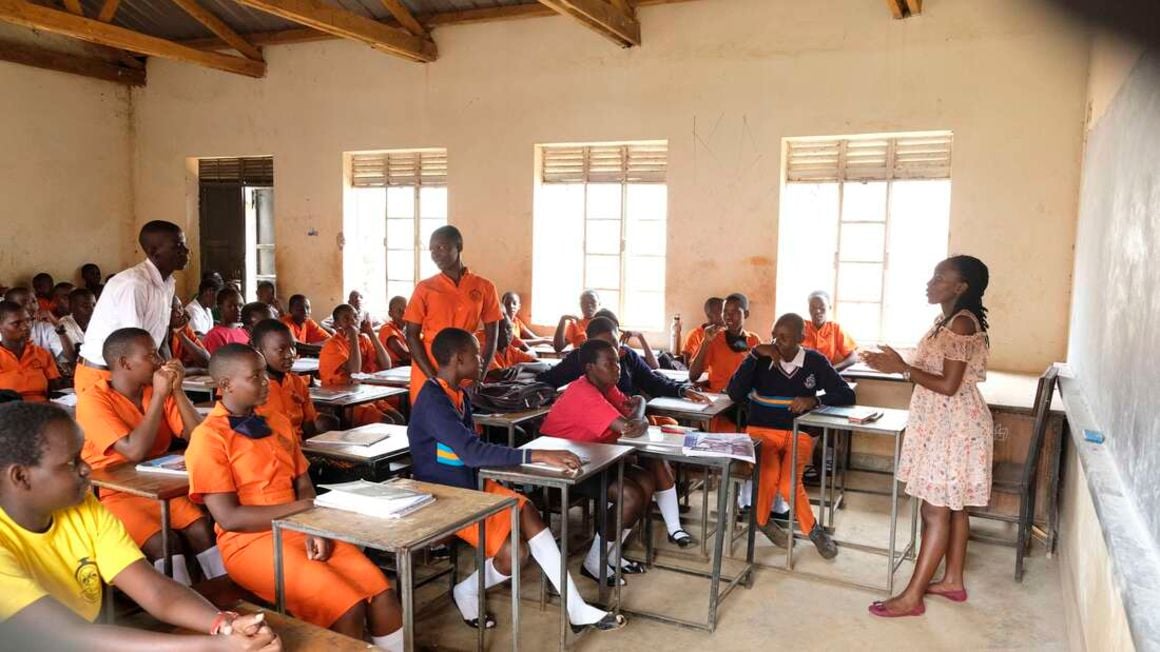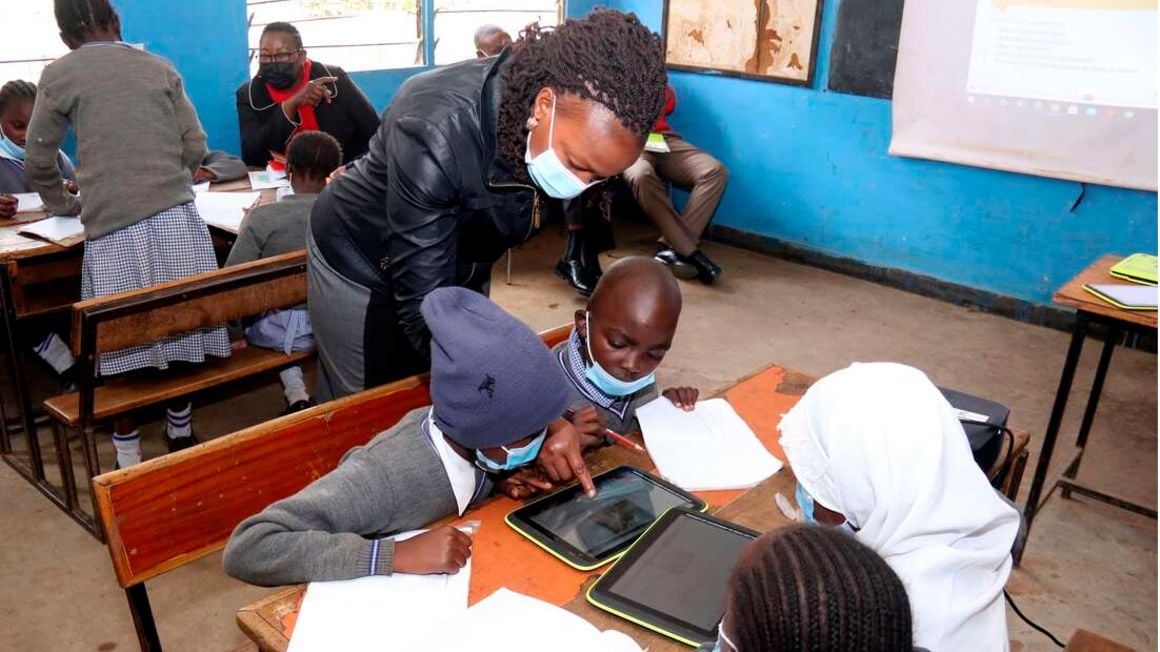
Florence Nakijoba, a Chinese language teacher, interacts with students during a lesson at Entebbe Comprehensive Secondary School in Wakiso, Uganda, April 5, 2022. PHOTO | XINHUA via AFP
Governments in the East African region see adjustments in their respective education system as one long-term solution to joblessness. But, while countries in the region all
agree to adjust what they teach, there is little common ground or harmony among them, some experts say.In Kenya, the Competency Based Curriculum (CBC) may first have to pass the resistance stage. Officials say it exposes children to their career interests right from elementary level. This, authorities add, can build a group of learners who can choose career paths without wasting time in learning everything. But, since the system was launched in 2017, it has been faced with complaints of high cost of learning materials, with parents most times forced to do homework with their children.
Kenya’s CBC is a 2-6-3-3-3 system, meaning pupils take two years in pre-primary level, six years in primary, three years in junior secondary, three years in senior secondary and three years in tertiary education. Since 1985, Kenya had been using the 8-4-4 system, where learners took 16 years to complete a cycle. It was criticised for just equipping students for exams rather than prepare them for world’s realities.
East African Community member countries have different education systems with learners spending between 16 years (South Sudan and Rwanda) and 20 years (Burundi) from pre-primary to university.
Focus of reforms
With this divergence, experts say reforms must focus on creating similar learning environments.
Samuel Otieno, director of the Regional Education Learning Initiative, an NGO on education policy in East Africa, says EAC states must address harmony especially since the labour market may expand under integration.
“What countries such as Tanzania and Uganda are doing is infusing 21st century skills into their curriculum while maintaining their system,” he said.
Pauline Musyoka a teacher at Mariakani Primary School in Nairobi shows Grade 3 pupils how to use a tablet during an e-learning event by Kenya Literature Bureau (KLB) on September 8, 2021. PHOTO | LUCY WANJIRU | NMG
A push for the harmonised curriculum, he said, will align the region’s economic needs and transform the quality of education. He argued that overhauling an education system is important, but the region must focus on same things to address issues such as proper preparation for learners, localising content and training enough teachers, besides raising funding allocation for teachers.
Rwanda has made great strides in its education system over the past 12 years, shifting from knowledge-based to the competency-based curriculum.
In Kenya, authorities say the CBC is a response to policy changes within the EAC.
“The East Africa Community Protocol 2012 precipitated harmonisation of curricula in East Africa and adoption of CBC in the region,” said Prof Charles Ong’ondo, chief executive of Kenya Institute of Curriculum Development.
The protocol required countries to adopt a competency-based curriculum to boost regional quality of education and align it with the global market skills.
The EAC Harmonised Curriculum Structures and Framework says a uniform curriculum will foster regional integration through facilitating easy movement of learners across states.
“This will only be achieved when the education systems in the respective countries domesticate the regional goals of education, objectives of primary education and key learning competencies,” the framework says.
Kenya is at Grade Six of the new curriculum and plans to admit the first cohort of junior secondary students in January 2023 despite criticism that the curriculum is unnecessary and un researched.
According to the Kenya’s CBC Taskforce report, at senior secondary school, learners will pursue three pathways: 60 percent stem (science, technology, engineering and mathematics) courses, 25 percent social sciences and 15 percent sports, science and art. Each senior secondary school should offer at least two pathways.
It is projected that in 2026, there will be 1.25 million learners transiting to senior secondary school, which calls for further expansion of the schools.
Currently, the government is constructing at least 10,000 classrooms worth Ksh8 billion ($68.6 million) in preparation for the junior secondary school rollout next year.
Spectre of unemployment
In Kenya, unemployment remains a challenge, as many youth are unable to find jobs after graduation. More than 800,000 students graduate yearly from various colleges and universities, but a low percentage secure jobs.
With the new curriculum, the government says students will be able to choose their preferred career paths at the senior secondary school and proceed with the path at the university and college level, giving them better chances in the global job market.
Education Ministry Principal Secretary for Implementation of Curriculum Reforms Prof Fatuma Chege said there will be a review of the secondary education placement guidelines to provide clear criteria, including the use of assessments, for placement of learners in junior secondary schools.
“The ministry has mapped all secondary schools and is progressively improving infrastructure and will provide necessary requirements for the rollout of the CBC in the schools,” she said.
The taskforce report has since recommended that the Ministry of Education should identify schools that can host the three pathways and progressively enhance their infrastructure capacity.
In Tanzania, the debate over knowledge versus competency-based education featured in parliament during a discussion on the Ministry of Education's 2022/2023 budget estimates.
Legislators pressed the government for planned education sector reforms, including a review of the curriculum to emphasise technical and life skills subjects and nurture talents and vocational skills from primary school.
Education Minister Prof Adolf Mkenda tabled a budget estimate of just below Tsh1.5 trillion ($649.3 million) for the 2022/2023 financial year, which will also cover education policy tweaks and proposed amendments to the 1978 National Education Act.
According to Prof Mkenda, reforms will emphasise vocational and technical education, adding that they will cover policy, curriculum, quality of teachers, trainers and lecturers, and teaching facilities.
Public concerns have been growing in over the competency of Tanzanian graduates in the job market.
MPs underscored the present reality, where many students completing basic primary, O-Level and A-Level education are finding themselves unemployable.
In his presentation, Prof Mkenda said the reforms would prevent haphazard imposition of unresearched and uncoordinated changes to education.




No comments :
Post a Comment